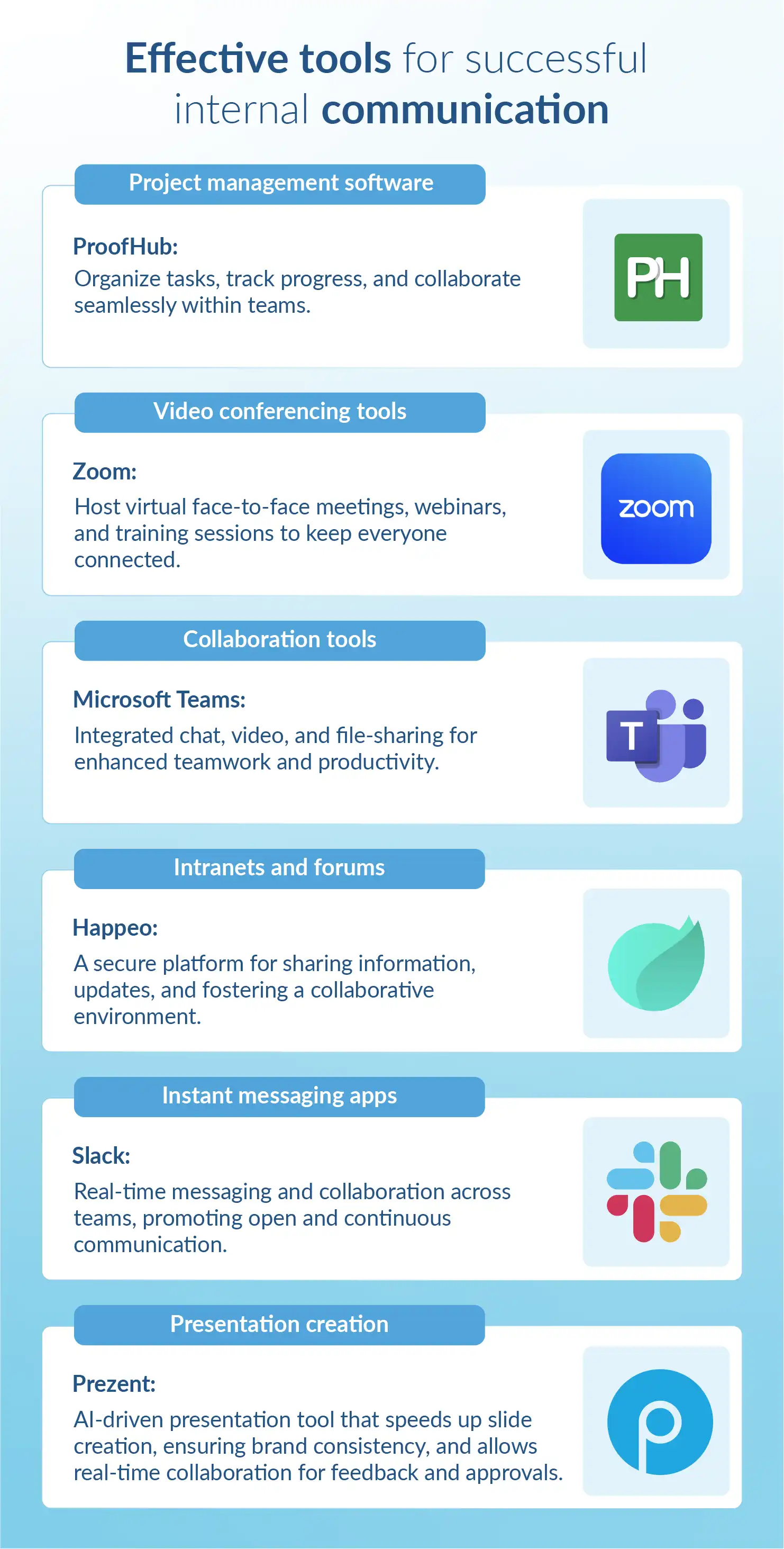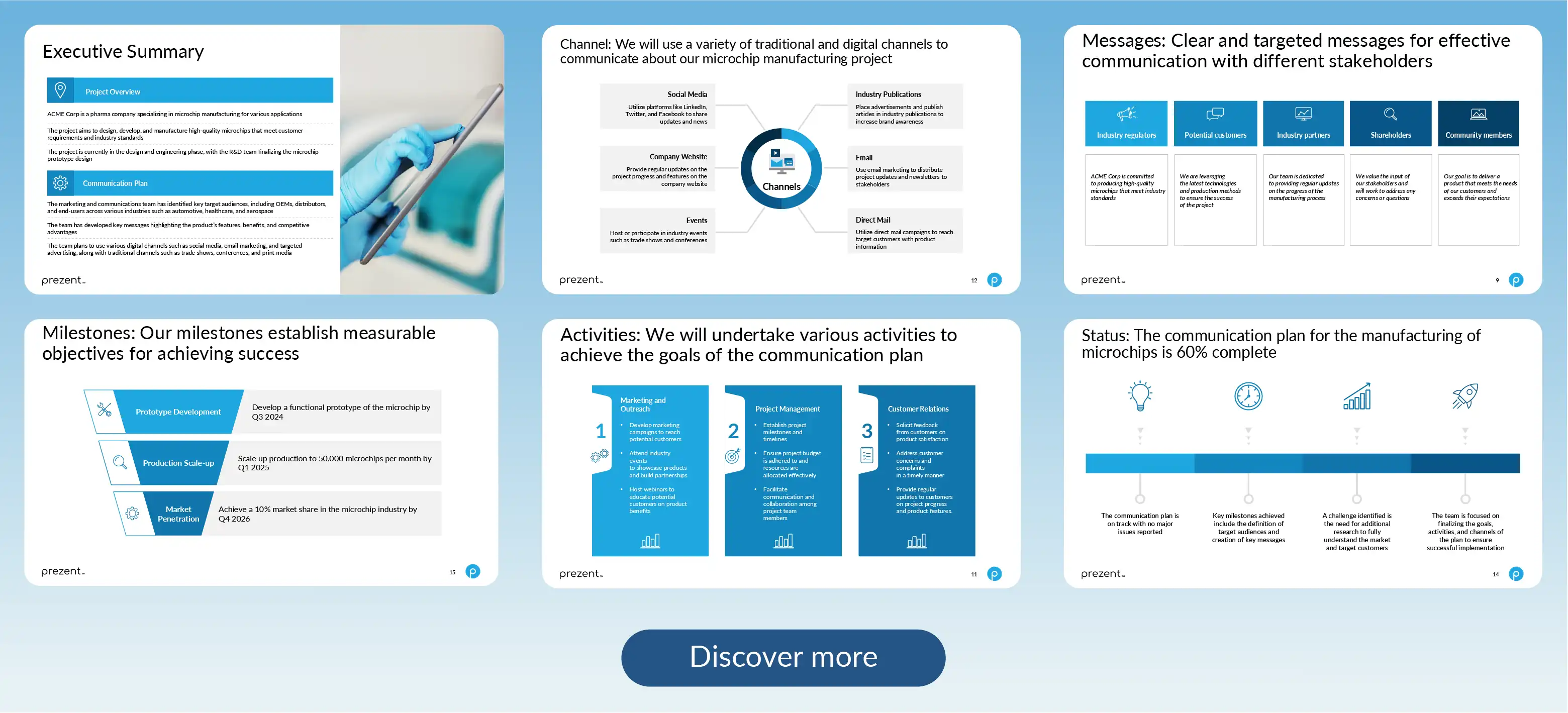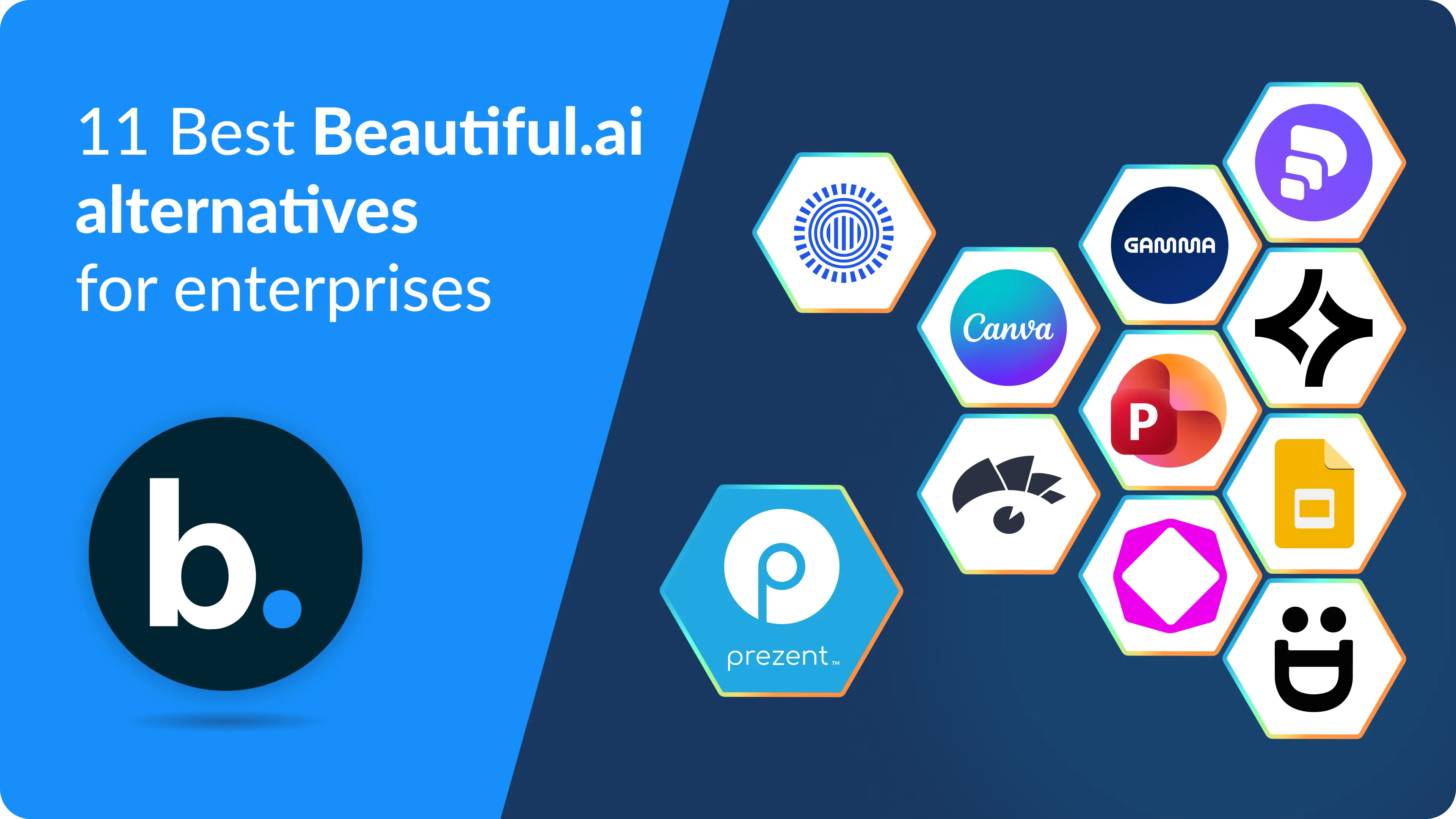Internal communication: Best practices for remote teams

Effective strategy and planning are crucial, but without strong communication, even the best-laid plans can fall apart. Imagine you have a critical product launch scheduled for Christmas, but it fails because key promotional channels were unaware of the campaign date. This highlights the essential role of internal communication. To execute plans successfully, internal communication must be as well-planned and synchronized as the business strategy itself.
In this article, we'll explore internal communication in depth and guide you in building a clear, open communication structure that ensures every plan is executed with precision.
What is internal communication?
Internal communication is the backbone of any organization, ensuring that information flows seamlessly across all levels. It's the exchange of ideas, updates, and feedback between employees, management, and even across departments. More than just a means of keeping everyone informed, internal communication fosters engagement and alignment, making sure every team member is working towards the same goals. When done right, it becomes the driving force that keeps the organization moving forward, connected, and unified.
Benefits of internal communication in business:
Before we get into the benefits of internal communication, let’s consider the example of a failed product launch. The launch faltered because the teams weren’t aligned. The marketing department was left in the dark, the sales team was unprepared, and customer support had no clue what was coming. While there could be various contributing factors, the root cause was a lack of alignment, leading to confusion, missed opportunities, and, ultimately, a failed launch.
This case itself speaks volumes about the requirement for internal communication in business.
- Alignment with organizational goals: Effective internal communication ensures that all employees are aware of the company's mission, vision, and strategic goals. This alignment drives collective efforts toward achieving these objectives.
- Employee engagement: Good communication fosters a sense of belonging and value among employees. Engaged employees are more likely to be productive, motivated, and committed to the organization's success.
- Efficient collaboration: Clear communication channels facilitate better team collaboration, leading to improved problem-solving, innovation, and overall efficiency.
- Crisis management: In times of crisis, effective internal communication is vital for quick decision-making, maintaining morale, and ensuring that everyone is on the same page.
Types of internal communication:
There are various types of internal communication within an organization. Here, we’ll focus on the top six that you are most likely to encounter in your workplace. Understanding and identifying each type will help you tailor your approach for more effective communication.
Management-to-employee communication:
This is the most common form of top-down communication, where managers or leaders share directives, updates, feedback, and motivational messages with their team members.
Objective: This communication aims to align employees with the organization's goals and objectives, ensuring everyone is focused and moving in the same direction.
Channels: Emails are the primary channel for management communication. However, meetings such as performance reviews or weekly briefs are also conducted to facilitate open, two-way communication. The reliance on digital communication tools has increased with the rise of remote work culture. Teams use video conferencing platforms and collaborative tools to ensure team alignment, even in remote work setups.
Employee-to-management communication:
This bottom-up communication involves employees sharing feedback, concerns, ideas, or updates with their managers or leaders. It plays a crucial role in empowering employees, fostering a culture of openness, and allowing management to make informed decisions.
Objective: To ensure that employee voices are heard, providing valuable insights that can guide management decisions and policies.
Channels: Traditionally, this type of communication occurs through suggestion boxes, performance reviews, or informal meetings. In a remote work setting, digital tools like anonymous surveys, virtual suggestion boxes, or direct messaging apps are more commonly used. Remote work emphasizes the need for transparent and accessible channels to ensure that employees feel connected and heard, even from a distance.
Peer-to-peer communication:
As the name suggests, this type of communication happens between colleagues at the same level, often within or across teams. It's essential for collaboration, knowledge sharing, and building strong working relationships.
Objective: To promote teamwork, collaboration, and the seamless flow of information between employees working on shared goals.
Channels: In-office settings might see this type of communication through face-to-face meetings, impromptu desk visits, or brainstorming sessions. On the other hand, in remote workplaces, online collaborative tools like Microsoft Team, zoom, and project management software are becoming vital. Virtual collaboration demands clearer and more intentional communication to compensate for the lack of physical proximity.
Information delivery:
Information delivery involves the distribution of essential updates, company-wide announcements, or important data to all employees. It ensures everyone is informed and up-to-date.
Objective: To provide timely and accurate information to all employees, minimizing confusion and ensuring everyone is aligned with company developments.
Channels: Earlier, most organizations used emails, newsletters, or company intranets. With the rise of remote work, organizations increasingly rely on centralized digital platforms like intranets, team communication apps, or video messages. It is crucial to ensure that information is accessible, clear, and reaches everyone, regardless of location.
Crisis management:
Crisis communication is vital during unexpected events or emergencies. It involves swiftly communicating critical information to employees to manage the situation effectively.
Objective: To quickly share important information, provide guidance, and maintain calm and order during a crisis.
Channels: Typically, crisis communication might involve urgent emails, emergency meetings, or phone calls. With remote work, instant messaging platforms, emergency notification systems, and video conferencing tools become essential. The remote nature of work increases the importance of having robust and reliable communication systems in place for quick action.
Change management:
Change management communication is necessary during periods of significant organizational change, such as mergers, restructuring, or new processes. It helps employees understand, adapt to, and embrace change.
Objective: These communications guide employees through changes, reduce resistance, and ensure a smooth transition.
Channels: Change management might involve town halls, training sessions, or detailed emails. In remote settings, webinars, virtual workshops, and detailed online resources are crucial. Remote work requires even more frequent and clear communication to help employees navigate changes without the benefit of in-person support.
Culture communication:
Cultural communication promotes and reinforces the company’s values, mission, and overall work culture. It’s key to maintaining a strong organizational identity and morale.
Objective: The aim is to build and maintain a positive, cohesive company culture, even in a dispersed work environment.
Channels: In-office, this might involve team-building events, recognition programs, or cultural initiatives. On the other hand, virtual events, recognition platforms, and consistent cultural messaging through digital channels are essential for remote work. Maintaining a strong company culture remotely requires creative approaches to ensure that employees feel connected and valued despite the physical distance.
Best practices for effective internal communication in a remote workplace
Internal communication has always been vital, but the rise of remote work has shifted its dynamics. Each type of internal communication—whether management-to-employee, peer-to-peer, or employee-to-management—has its own advantages and challenges, especially in a remote context. With remote work becoming the norm post-pandemic, many employees enjoy the benefits of saved commute time and increased flexibility. However, a significant portion of the workforce struggles with feelings of disconnection, insecurity, and a lack of social interaction.
A 2023 survey by Bankrate reveals some concerning trends:
- 30% of workers will likely quit their jobs in the next 12 months.
- 33% are worried about their job security.
- 56% actively consider searching for a new job within the next year.
These statistics indicate that poor internal communication, especially in a remote setting, can contribute to employee dissatisfaction, a heightened sense of job insecurity, and an increase in turnover. Strengthening communication practices is crucial to preventing disengagement and fostering a supportive and connected workforce.
Many organizations have implemented essential internal communication strategies to enhance effectiveness, including:
- Open two-way communication: Fostering a transparent culture that encourages employees to share thoughts, opinions, and ideas.
- Use of collaborative tools: Utilizing project management software and messaging apps to facilitate smooth teamwork and coordination.
- Team-building activities: Organizing virtual or in-person activities to strengthen relationships and boost team morale.
- Regular employee surveys and meetings: Conducting surveys and holding regular meetings to gather feedback and address concerns promptly.
- Achievement recognition: Celebrating and acknowledging employee successes to boost motivation and engagement.
Remote work culture is shifting the focus of HR teams towards employee engagement to ensure inclusivity, security, and alignment with business goals. To achieve this, HR must develop a robust communication plan that emphasizes transparency, fosters employee engagement, and drives overall success. Here are some best practices to help you refine your plan:
Set clear and measurable goals:
Before refining your communication plan, start by setting clear, measurable goals. These goals should be based on the unique needs of your workforce. Conduct anonymous surveys or feedback sessions to understand what areas need improvement—whether it’s better tools, more frequent communication, or addressing specific pain points. Knowing your employees' wants will help you shape a more targeted, effective communication strategy.
Tailor messages to different audiences:
One-size-fits-all communication doesn’t work in a diverse, remote workforce. Customize your messaging based on the needs of various employee segments, such as remote workers, managers, or specific departments. For example, executives may need more strategic updates, while individual contributors require practical guidance and operational information. This personalization ensures communication is relevant, engaging, and impactful for everyone.
Leverage the right internal communication tools:
Technology is key to bridging communication gaps in a remote environment. Implement collaborative tools such as Slack, Zoom, Microsoft Teams, or project management platforms like Asana or Trello. AI-driven tools like Prezent also simplify business communication, helping professionals create presentations efficiently without consuming excessive time. These tools promote real-time collaboration, document sharing, and team connectivity, minimizing isolation and improving engagement. It is also a good idea to ensure the chosen tools are user-friendly and fit well with the company’s existing processes.

Build a robust feedback loop:
Two-way communication is critical for creating a connected and motivated workforce. Design a system where employees can easily share their feedback, ideas, and concerns. Regular surveys, virtual town halls, anonymous suggestion boxes, and team meetings are all effective ways to gather insights from your staff. More importantly, listen actively to what they have to say and implement their suggestions when feasible. This shows employees that their input is valued and helps foster trust and loyalty.
Regularly assess internal communication strategies:
Continuous improvement is vital. Regularly evaluate your communication strategies by gathering employee feedback through surveys, focus groups, or one-on-one interviews. Monitor key performance indicators like engagement rates, meeting attendance, or response times to gauge effectiveness. Identifying what works and what doesn’t. This will help you fine-tune your approach and ensure communication efforts meet organizational and employee needs.
Evaluate and implement learnings:
Adaptability is essential in a dynamic remote work environment. After each communication cycle or project, review what worked well and where there were gaps. Use data from surveys, engagement metrics, and feedback to implement best practices and address areas for improvement. Regular evaluation will allow you to continuously optimize your communication plan, leading to better employee engagement and more efficient communication.
Ensure consistent transparency:
In a remote setup, where non-verbal cues are less apparent, transparency becomes even more important. Regularly share updates from leadership, including both successes and challenges. Keeping employees informed about business goals, company performance, and any significant developments builds trust and keeps everyone aligned with the organization’s mission. Transparent communication also helps employees feel more secure, connected, and valued within the company.
Example of communication plan:
A well-crafted communication plan is the backbone of effective internal communication. It ensures that messages are clear, timely, and aligned with the company's goals. By providing structure and consistency, a communication plan helps keep employees engaged, informed, and connected, fostering a culture of transparency and reducing the chances of miscommunication.
Here is a communication plan template to help you effectively convey your strategies and plans to all relevant stakeholders. It ensures clear, consistent messaging and fosters alignment across your team, enabling smoother implementation and greater success in achieving your objectives.

FAQ's
1. How does employee communication improve engagement and productivity?
Employee communication is crucial for building a strong internal communication structure. When everyone in the organization understands their role and responsibilities, engagement, motivation, and productivity increase.
2. What are the best ways to implement an internal communication plan?
A well-crafted internal communication plan involves setting clear goals, using the right tools, and tailoring messages for different audiences. This ensures that information flows seamlessly and is aligned with business objectives.
3. How can internal communication help during change management?
Internal communication is a valuable tool for guiding employees through organizational changes. It reduces resistance by providing clarity, updates, and support, helping staff adapt more smoothly to new processes or structures.
4. What role does personalized communication play in internal communications?
Personalized communication helps improve internal communications by ensuring messages are relevant and engaging for each employee segment. This approach ensures that everyone receives the information they need to perform at their best.
5. Why is strong internal communication important for corporate communication strategies?
Strong internal communication lays the foundation for successful corporate communication by fostering alignment, transparency, and trust. It ensures that the organization speaks with one voice, both internally and externally.
How vital are presentations in internal communication?
Presentations are an essential part of internal communication. They serve as a powerful tool to convey information, ideas, and strategies within an organization.
Information sharing:
Presentations are often used in meetings, town halls, and training sessions to share important updates, project progress, or new initiatives with employees. They help ensure that everyone has the same understanding of critical topics.
Alignment and strategy communication:
When leaders present the company's vision, goals, and strategies, they align employees with the organization’s direction. This helps in creating a unified approach toward achieving business objectives.
Training and development:
Presentations are commonly used in training sessions to educate employees about new processes, tools, or skills. This form of communication is crucial for ensuring that employees are well-equipped to perform their roles effectively.
Employee engagement:
Interactive presentations can engage employees, encourage participation, and facilitate discussions. This interaction fosters a two-way communication channel, making presentations a valuable tool for feedback and idea exchange.
Project updates and reporting:
Teams often use presentations to report on project status, milestones, and challenges. This ensures that all stakeholders are informed and can make decisions based on up-to-date information.
Problem-solving and decision-making:
Presentations can be used to outline challenges, propose solutions, and facilitate decision-making processes within teams or across departments.
AI tools like Prezent are revolutionizing presentation creation, making it easier and more impactful for professionals to focus on their core tasks. With powerful features like Story-builder, Auto-generator, and Slide templates, Prezent not only speeds up the process but also ensures brand consistency across all presentations effortlessly.
In the post-pandemic era, where internal communication faces challenges due to coordination gaps, communication silos, and misinformation, Prezent's collaboration feature allows teams to work together seamlessly on presentations. Teams can receive real-time feedback and approvals on ongoing projects, promoting better coordination and ensuring that everyone stays aligned. This fosters a more efficient workflow and enhances the overall quality of internal communication, even in a remote or hybrid work environment.
Discover more about Prezent's powerful features and how it can streamline your presentation process. Schedule a demo or sign up for a free trial to experience firsthand how Prezent can transform your business communications, making them more efficient, engaging, and consistent across your organization.










.avif)

